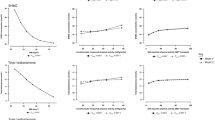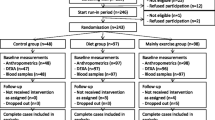Abstract
An association between physical activity and premenopausal breast cancer risk may be due, in part, to relationships with sex hormones or growth factors. Therefore, we assessed whether MET-h/week of total physical activity (moderate-to-vigorous intensity), walking, or vigorous physical activity, and h/week of standing or sitting were associated with plasma concentrations of several hormones. We examined levels of estrogens, androgens, progesterone, prolactin, sex hormone binding globulin (SHBG), insulin-like growth factor-1 (IGF-1), IGF binding protein-3, and growth hormone (GH) in 565 premenopausal women, ages 33–52 years, from the Nurses’ Health Study II (NHSII). About 87% of women had both timed follicular and luteal samples; other women had one untimed sample. In general we observed few associations between sex hormone or IGF levels and measures of physical activity or inactivity. However, free testosterone was modestly inversely associated with total physical activity (p-trend = 0.02). Luteal estradiol, free estradiol, and estrone also were inversely associated with total physical activity (p-trend = 0.10, 0.04, 0.01, respectively); however, the trend was substantially attenuated when excluding women with anovulatory cycles or irregular cycles. These cross-sectional results suggest that physical activity and inactivity have limited associations with premenopausal sex hormone and growth factor levels, except possibly luteal estrogens.
Similar content being viewed by others
References
IARC (2002) Weight control and physical activity. IARC Handbooks of cancer prevention. IARC Press, Lyon
McTiernan A, Tworoger SS, Ulrich CM et al (2004) Effect of exercise on serum estrogens in postmenopausal women: a 12-month randomized clinical trial. Cancer Res 64:2923–2928
Key T, Appleby P, Barnes I, Reeves G (2002) Endogenous sex hormones and breast cancer in postmenopausal women: reanalysis of nine prospective studies. J Natl Cancer Inst 94:606–616
De Cree C (1998) Sex steroid metabolism and menstrual irregularities in the exercising female. A review. Sports Med 25:369–406
Yan L, Johnson WO, Gold EB, Lasley BL (2004) Bayesian analysis of risk factors for anovulation. Stat Med 23:1901–1919
De Souza MJ, Miller BE, Loucks AB et al (1998) High frequency of luteal phase deficiency and anovulation in recreational women runners: blunted elevation in follicle-stimulating hormone observed during luteal-follicular transition. J Clin Endocrinol Metab 83:4220–4232
Greene JW (1993) Exercise-induced menstrual irregularities. Compr Ther 19:116–20
Verkasalo PK, Thomas HV, Appleby PN, Davey GK, Key TJ (2001) Circulating levels of sex hormones and their relation to risk factors for breast cancer: a cross-sectional study in 1092 pre- and postmenopausal women (United Kingdom). Cancer Causes Control 12:47–59
Allen NE, Appleby PN, Kaaks R, Rinaldi S, Davey GK, Key TJ (2003) Lifestyle determinants of serum insulin-like growth-factor-I (IGF-I), C-peptide and hormone binding protein levels in British women. Cancer Causes Control 14:65–74
Schmitz KH, Ahmed RL, Yee D (2002) Effects of a 9-month strength training intervention on insulin, insulin-like growth factor (IGF)-I, IGF-binding protein (IGFBP)-1, and IGFBP-3 in 30–50-year-old women. Cancer Epidemiol Biomarkers Prev 11:1597–1604
Eliakim A, Brasel JA, Mohan S, Barstow TJ, Berman N, Cooper DM (1996) Physical fitness, endurance training, and the growth hormone-insulin-like growth factor I system in adolescent females. J Clin Endocrinol Metab 81:3986–3992
Landin-Wilhelmsen K, Wilhelmsen L, Lappas G et al (1994) Serum insulin-like growth factor I in a random population sample of men and women: relation to age, sex, smoking habits, coffee consumption and physical activity, blood pressure and concentrations of plasma lipids, fibrinogen, parathyroid hormone and osteocalcin. Clin Endocrinol (Oxf) 41:351–357
Lukanova A, Toniolo P, Akhmedkhanov A et al (2001) A cross-sectional study of IGF-I determinants in women. Eur J Cancer Prev 10:443–452
Voskuil DW, Bueno de Mesquita HB, Kaaks R et al (2001) Determinants of circulating insulin-like growth factor (IGF)-I and IGF binding proteins 1–3 in premenopausal women: physical activity and anthropometry (Netherlands). Cancer Causes Control 12:951–958
Hakkinen K, Pakarinen A, Hannonen P et al (2002) Effects of strength training on muscle strength, cross-sectional area, maximal electromyographic activity, and serum hormones in premenopausal women with fibromyalgia. J Rheumatol 29:1287–1295
Shangold MM, Gatz ML, Thysen B (1981) Acute effects of exercise on plasma concentrations of prolactin and testosterone in recreational women runners. Fertil Steril 35:699–702
Kraemer RR, Blair MS, McCaferty R, Castracane VD (1993) Running-induced alterations in growth hormone, prolactin, triiodothyronine, and thyroxine concentrations in trained and untrained men and women. Res Q Exerc Sport 64:69–74
Chang FE, Dodds WG, Sullivan M, Kim MH, Malarkey WB (1986) The acute effects of exercise on prolactin and growth hormone secretion: comparison between sedentary women and women runners with normal and abnormal menstrual cycles. J Clin Endocrinol Metab 62:551–556
Luger A, Watschinger B, Deuster P, Svoboda T, Clodi M, Chrousos GP (1992) Plasma growth hormone and prolactin responses to graded levels of acute exercise and to a lactate infusion. Neuroendocrinology 56:112–117
van der Pompe G, Bernards N, Kavelaars A, Heijnen C (2001) An exploratory study into the effect of exhausting bicycle exercise on endocrine and immune responses in post-menopausal women: relationships between vigour and plasma cortisol concentrations and lymphocyte proliferation following exercise. Int J Sports Med 22:447–453
Tworoger SS, Sluss P, Hankinson SE (2006) Association between plasma prolactin concentrations and risk of breast cancer among predominately premenopausal women. Cancer Res 66:2476–2482
Missmer SA, Spiegelman D, Bertone-Johnson ER, Barbieri RL, Pollak MN, Hankinson SE (2006) Reproducibility of Plasma Steroid Hormones, Prolactin, and Insulin-like Growth Factor Levels among Premenopausal Women over a 2- to 3-Year Period. Cancer Epidemiol Biomarkers Prev 15:972–978
Colditz GA, Feskanich D, Chen WY, Hunter DJ, Willett WC (2003) Physical activity and risk of breast cancer in premenopausal women. Br J Cancer 89:847–851
Wolf AM, Hunter DJ, Colditz GA et al (1994) Reproducibility and validity of a self-administered physical activity questionnaire. Int J Epidemiol 23:991–999
Hankinson SE, Willett WC, Manson JE et al (1982) Plasma sex steroid hormone levels and risk of breast cancer in postmenopausal women. J Natl Cancer Inst 90:1292–1299
Sodergard R, Backstrom T, Shanbhag V, Carstensen H (1982) Calculation of free and bound fractions of testosterone and estradiol-17 beta to human plasma proteins at body temperature. J Steroid Biochem 16:801–810
Eliassen AH, Missmer SA, Tworoger SS et al (2006) Endogenous steroid hormone concentrations and risk of breast cancer among predominantly premenopausal women. J Natl Cancer Inst 98:1406–1415
Schernhammer ES, Holly JM, Hunter DJ, Pollak MN, Hankinson SE (2006) Insulin-like growth factor-I, its binding proteins (IGFBP-1 and IGFBP-3), and growth hormone and breast cancer risk in The Nurses Health Study II. Endocr Relat Cancer 13:583–592
Tworoger SS, Missmer SA, Eliassen AH et al (2006) The Association of Plasma DHEA and DHEA Sulfate with Breast Cancer Risk in Predominantly Premenopausal Women. Cancer Epidemiol Biomarkers Prev 15:967–971
Rosner B (1983) Percentage points for generalized ESD many-outlier procedure. Technometrics 25:165–172
Strauss JF, Barbieri RL (2004) Yen and Jaffe’s Reproductive Endocrinology. Elsevier Saunders, Philadelphia
Fung TT, Hu FB, Yu J et al (2000) Leisure-time physical activity, television watching, and plasma biomarkers of obesity and cardiovascular disease risk. Am J Epidemiol 152:1171–1178
Hu FB, Leitzmann MF, Stampfer MJ, Colditz GA, Willett WC, Rimm EB (2001) Physical activity and television watching in relation to risk for type 2 diabetes mellitus in men. Arch Intern Med 161:1542–1548
Hu FB, Li TY, Colditz GA, Willett WC, Manson JE (2003) Television watching and other sedentary behaviors in relation to risk of obesity and type 2 diabetes mellitus in women. Jama 289:1785–1791
Kronenberg F, Pereira MA, Schmitz MK et al (2000) Influence of leisure time physical activity and television watching on atherosclerosis risk factors in the NHLBI Family Heart Study. Atherosclerosis 153:433–443
Salmon J, Bauman A, Crawford D, Timperio A, Owen N (2000) The association between television viewing and overweight among Australian adults participating in varying levels of leisure-time physical activity. Int J Obes Relat Metab Disord 24:600–606
Hosmer DW, Lemeshow S (1989) Applied Logistic Regression. John Wiley & Sons, New York
Yen S, Jaffe R, Barbieri R (1999) Reproductive endocrinology: physiology, pathophysiology, and clinical management. W.B. Saunders Co, Philadelphia
Bernstein L, Ross RK, Lobo RA, Hanisch R, Krailo MD, Henderson BE (1987) The effects of moderate physical activity on menstrual cycle patterns in adolescence: implications for breast cancer prevention. Br J Cancer 55:681–685
Russell JB, Mitchell D, Musey PI, Collins DC (1984) The relationship of exercise to anovulatory cycles in female athletes: hormonal and physical characteristics. Obstet Gynecol 63:452–456
Nagata C, Kaneda N, Kabuto M, Shimizu H (1997) Factors associated with serum levels of estradiol and sex hormone-binding globulin among premenopausal Japanese women. Environ Health Perspect 105:994–997
Kaaks R, Berrino F, Key T et al (2005) Serum sex steroids in premenopausal women and breast cancer risk within the European Prospective Investigation into Cancer and Nutrition (EPIC). J Natl Cancer Inst 97:755–765
De Pergola G, Zamboni M, Sciaraffia M et al (1996) Body fat accumulation is possibly responsible for lower dehydroepiandrosterone circulating levels in premenopausal obese women. Int J Obes Relat Metab Disord 20:1105–1110
Baker ER, Mathur RS, Kirk RF, Landgrebe SC, Moody LO, Williamson HO (1982) Plasma gonadotropins, prolactin, and steroid hormone concentrations in female runners immediately after a long-distance run. Fertil Steril 38:38–41
Tworoger SS, Sorensen B, Chubak J et al (2007) Effect of a 12-month randomized clinical trial of exercise on serum prolactin concentrations in postmenopausal women. Cancer Epidemiol Biomarker Prev 16:895–899
Goodman-Gruen D, Barrett-Connor E (1997) Epidemiology of insulin-like growth factor-I in elderly men and women. The Rancho Bernardo Study. Am J Epidemiol 145:970–976
McTiernan A, Ulrich C, Slate S, Potter J (1998) Physical activity and cancer etiology: associations and mechanisms. Cancer Causes Control 9:487–509
Adams SA, Matthews CE, Hebert JR et al (2006) Association of physical activity with hormone receptor status: the Shanghai Breast Cancer Study. Cancer Epidemiol Biomarkers Prev 15:1170–1178
Enger SM, Ross RK, Paganini-Hill A, Carpenter CL, Bernstein L (2000) Body size, physical activity, and breast cancer hormone receptor status: results from two case–control studies. Cancer Epidemiol Biomarkers Prev 9:681–687
Westerlind KC, McCarty HL, Gibson KJ, Strange R (2002) Effect of exercise on the rat mammary gland: implications for carcinogenesis. Acta Physiol Scand 175:147–156
Zhang C, Solomon CG, Manson JE, Hu FB (2006) A prospective study of pregravid physical activity and sedentary behaviors in relation to the risk for gestational diabetes mellitus. Arch Intern Med 166:543–548
Rich-Edwards JW, Spiegelman D, Garland M et al (2002) Physical activity, body mass index, and ovulatory disorder infertility. Epidemiology 13:184–190
Author information
Authors and Affiliations
Corresponding author
Additional information
Support for this project was from NIH grants CA67262, CA50385, P50 CA089393, and DAMD-17-02-1-0692. Dr. Eliassen was supported by Cancer Education and Career Development Grant R25 CA 098566-2 from the National Cancer Institute.
Electronic supplementary material
Below is the link to the electronic supplementary material.
Rights and permissions
About this article
Cite this article
Tworoger, S.S., Missmer, S.A., Eliassen, A.H. et al. Physical activity and inactivity in relation to sex hormone, prolactin, and insulin-like growth factor concentrations in premenopausal women. Cancer Causes Control 18, 743–752 (2007). https://doi.org/10.1007/s10552-007-9017-5
Received:
Accepted:
Published:
Issue Date:
DOI: https://doi.org/10.1007/s10552-007-9017-5




